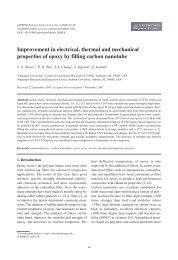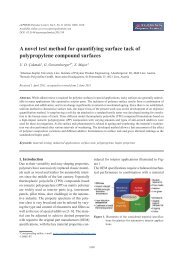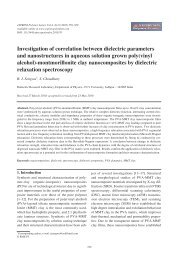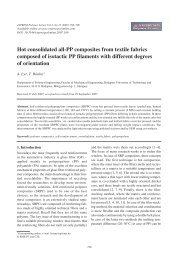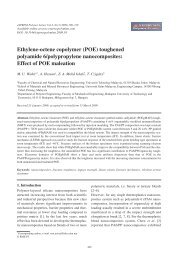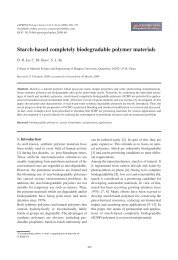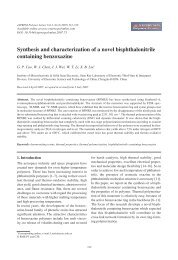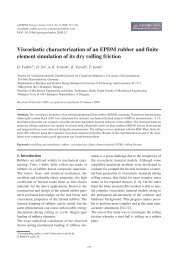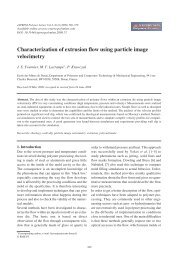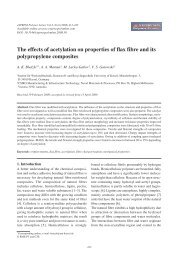Nanotechnology and its applications in lignocellulosic composites, a ...
Nanotechnology and its applications in lignocellulosic composites, a ...
Nanotechnology and its applications in lignocellulosic composites, a ...
You also want an ePaper? Increase the reach of your titles
YUMPU automatically turns print PDFs into web optimized ePapers that Google loves.
Kamel – eXPRESS Polymer Letters Vol.1, No.9 (2007) 546–575<br />
Figure 10. Chemical structure of ethylene oxideepichlorohydr<strong>in</strong><br />
coploymer<br />
should be used for unfilled electrolytes <strong>in</strong> order to<br />
ensure satisfactory mechanical properties. It was<br />
also shown that tunic<strong>in</strong> whiskers seem to have no<br />
effect on the conduction mechanism of the polymer<br />
electrolyte. Therefore, the used cross-l<strong>in</strong>ked nanocomposite<br />
polymer electrolytes allow conciliat<strong>in</strong>g<br />
both higher ionic conductivities <strong>and</strong> higher mechanical<br />
performances [154]. Lithium perchlorate-doped<br />
nano<strong>composites</strong> of ethylene oxide-epichlorohydr<strong>in</strong><br />
copolymers <strong>and</strong> cellulose whiskers can readily be<br />
produced by solution cast<strong>in</strong>g tetrahydrofuran/water<br />
mixtures compris<strong>in</strong>g the components <strong>and</strong> subsequent<br />
compression mold<strong>in</strong>g of the result<strong>in</strong>g nano<strong>composites</strong>.<br />
Films of these materials display substantially<br />
improved mechanical properties, when<br />
compared to the not re<strong>in</strong>forced lithium perchlorate/ethylene<br />
oxide-epichlorohydr<strong>in</strong> (Figure 10),<br />
<strong>and</strong> their electrical conductivities experience comparably<br />
small reductions [90].<br />
High performance solid lithium-conduct<strong>in</strong>g nanocomposite<br />
polymer electrolytes based on poly (oxy<br />
ethylene) were prepared from high aspect ratio cellulosic<br />
whiskers <strong>and</strong> lithium trifluoro methane sulfonyl<br />
imide. The filler provided a high re<strong>in</strong>forc<strong>in</strong>g<br />
effect while a high level of ionic conductivity was<br />
reta<strong>in</strong>ed with respect to the unfilled polymer electrolytes<br />
[155, 156].<br />
4.6. In biomedical<br />
From a biological viewpo<strong>in</strong>t, almost all of the<br />
human tissues <strong>and</strong> organs are deposited <strong>in</strong> nanofibrous<br />
forms or structures. Examples <strong>in</strong>clude: bone,<br />
dent<strong>in</strong>, collagen, cartilage, <strong>and</strong> sk<strong>in</strong>. All of them are<br />
characterized by well organized hierarchical<br />
fibrous structures. In biomedical <strong>applications</strong>, for<br />
soft tissue replacement a developed material that<br />
will not only display similar mechanical properties<br />
as the tissue it is replac<strong>in</strong>g, but also shows<br />
improved life span, biocompatibility, nonthrombogenic,<br />
<strong>and</strong> low degree of calcification needed.<br />
Hydrophilic bacterial cellulose fibers of an average<br />
diameter of 50 nm are produced by the bacterium<br />
Acetobacter xyl<strong>in</strong>um, us<strong>in</strong>g a fermentation process.<br />
They can be used <strong>in</strong> comb<strong>in</strong>ation with poly (v<strong>in</strong>yl<br />
alcohol) to form biocompatible nano<strong>composites</strong>.<br />
Millon et al. [157] prepared poly (v<strong>in</strong>yl alcohol)/<br />
bacterial cellulose nano<strong>composites</strong> <strong>and</strong> they found<br />
that, the result<strong>in</strong>g nano<strong>composites</strong> possess a broad<br />
range of mechanical properties <strong>and</strong> can be made<br />
with mechanical properties similar to that of cardiovascular<br />
tissues, such as aorta <strong>and</strong> heart valve<br />
leaflets.<br />
Silk fibro<strong>in</strong>-microcrystall<strong>in</strong>e cellulose (cellulose<br />
whisker) composite films with varied compositions<br />
were prepared by cast<strong>in</strong>g mixed aqueous solution/<br />
suspensions of the two components. Silk fibro<strong>in</strong><br />
was dissolved <strong>in</strong> lithium thiocyanate followed by<br />
dialysis; a cellulose whisker suspension was prepared<br />
by sulfuric acid hydrolysis of tunicate cellulose.<br />
Composite films showed improved mechanical<br />
strength at 20–30 wt% fibro<strong>in</strong> content, with<br />
break<strong>in</strong>g strength <strong>and</strong> ultimate stra<strong>in</strong> about five<br />
times those of the constituent materials. From the<br />
observed shift <strong>in</strong> the <strong>in</strong>frared absorption b<strong>and</strong>s of<br />
amide I <strong>and</strong> amide II of fibro<strong>in</strong>, the anomaly <strong>in</strong> the<br />
mechanical strength is considered to arise from the<br />
contact of fibro<strong>in</strong> with the highly ordered surface of<br />
cellulose whiskers. This phenomenon is not practicable<br />
for produc<strong>in</strong>g bulk materials because of the<br />
lengthy procedure of solubilization <strong>and</strong> dialysis<br />
<strong>in</strong>volved, but may be useful <strong>in</strong> biomedical <strong>applications</strong><br />
such as for cell culture media <strong>and</strong> implant<br />
materials, s<strong>in</strong>ce both components are chemically<br />
<strong>in</strong>ert <strong>and</strong> known to be compatible with liv<strong>in</strong>g tissues<br />
[158]. Hydroxyapatite (Ca 10 (PO 4 ) 6 (OH) 2 )-<br />
bacterial cellulose as a novel class of nano<strong>composites</strong><br />
were prepared by Wan et al. [159, 160]. The<br />
structure characteriz<strong>in</strong>g reveals that the crystallite<br />
sizes of the hydroxyapatite crystals are nano-sized<br />
<strong>and</strong> their crystall<strong>in</strong>ities are low. The Fourier-Transformed<br />
Infrared spectroscopy results show that<br />
hydroxyapatite crystals are formed when the phosphorylated<br />
<strong>and</strong> CaCl 2 -treated bacterial cellulose<br />
fibers are soaked <strong>in</strong> a 1.5 simulated body fluid the<br />
hydroxyapatite crystals are partially substituted<br />
with carbonate, resembl<strong>in</strong>g natural bones. The<br />
nano<strong>composites</strong> conta<strong>in</strong><strong>in</strong>g hydroxyapatite with<br />
structural features close to those of biological<br />
apatites are attractive for <strong>applications</strong> as artificial<br />
bones. From the scheme, it is believed that the nonionic<br />
hydroxyl groups on the unphosphorylated<br />
bacterial cellulose may firstly b<strong>in</strong>d the calcium ions<br />
565




